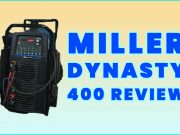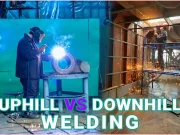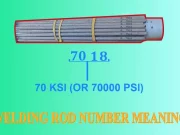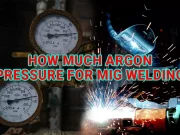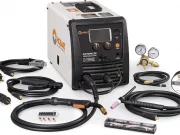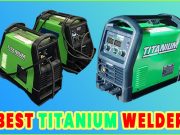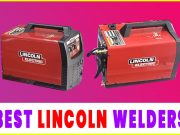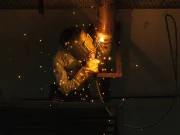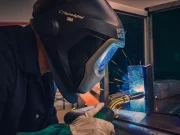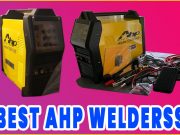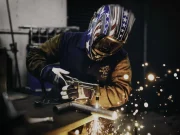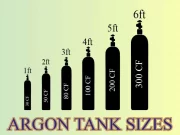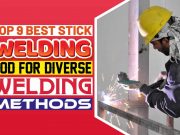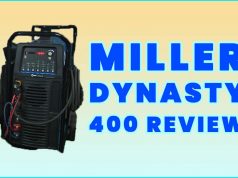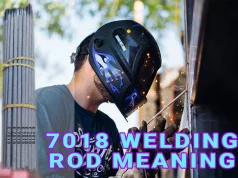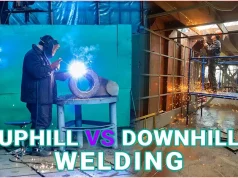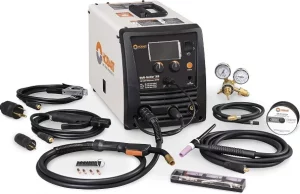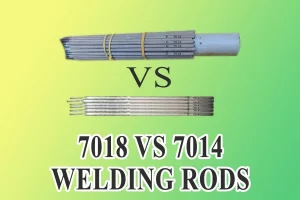
When fabricating two pieces of metal together, using the correct welding rod is important. There are so many welding rods, each having specific applications and being used in different circumstances.
Using the correct welding rod assures you of a proper and firm bind. The joints are unlikely to unravel even under sheer stress. It assures you of quality.
We measure rod sizes on a graduating scale from 6010 to 7024. Click here to get the full guide on different welding sizes.
Two potentially confusing welding rods are the 7018 and the 7014. People tend to mistake their uses and applications all the time.
Today, our focus is on 7018 and 7014. We shall discuss the differences, similarities, uses and other topics related to the two welding materials.
Key Differences Between 7018 And 7014 Welding Rods
There are several differences between the 7018 and 7014 welding rods. These differences are what determine the applications for each rod.
The differences are structural and lie in the composition of each metal and other subtle characteristics that are not visible to the naked eye.
Let us look at the key differences:
1. Differences in polarity
Where polarity is a concern, there are both similarities and differences in the 7018 and the 7014 rods.
The 7018 and 7014 welding rods both use the DCEP. In this connection, you connect the base metal to the negatively charged terminal and the welding electrode to the positive.
The 7018 and 7014 welding rods also weld using AC as the main power source. The difference comes in when using DCEN.
The 7014 rods can use DCEN to connect the lead to the negatively charged terminal and the work to the positive terminal. The welding results are great for this connection but are disappointing with the 7018 rods.
2. Flux differences
There are major structural differences between the 7014 and the 7018 welding rods.
The 7014 rods, for instance, have a high concentration of iron powder in their structure compared to the 7018 rods. It has implications on its application.
If you are looking to perform a penetrative weld, then the 7014 will not be ideal for the task. The 7014 is less penetrative when used with a Direct Current source.
The 7018 rod is a low hydrogen electrode. It is perfect for penetrative welds, particularly using DCEN power.
Unfortunately, low hydrogen electrodes are highly susceptible to water damage and should be used in dry conditions.
3. Slag Properties
There are certain observable differences in the slug properties of both welding rods. The slugs also share certain similarities.
Both slug types are thicker than what you would get in other welding rods like the 6010 or the 6011, which you can learn about by clicking here. It makes the 7014 and 7018 rods better suited for heavier welds.
The key difference on the 7014 and 7018 slugs is the viscous properties. The 7018 rod has a less dense slug.
It is more fluid than that of the 7014 rods. Once the weld has settled, the 7018 slugs are less prone to pealing than the 7014 slugs.
4. Storage requirements
All welding rods require different storage requirements based on their mental characteristics. Some metals are more volatile and tend to be reactive.
How you store the 7014 rods differs from how you store the 7018. The 7018 rods require specialized storage because of their low hydrogen property.
It makes the metal highly reactive and readily binds with hydrogen ions in the air leading to rapid deterioration.
The 7018 rods, therefore, require specialized storage to prevent them from binding with hydrogen.
The 7014 rods are not as reactive to the environment. You can store the metals in the open air, and they will not undergo any visible corrosion or structural changes.
Similarities Between The 7018 And 7014 Welding Rods
Despite the considerable difference between the welding rods, they share many common properties. These similarities do not mean that you can use them interchangeably.
These welding rods share some structural similarities that you can observe in their properties.
Some of the key similarities include:
1. Similar tensile strength
Tensile strength is the maximum stretch stress a substance can undergo before breaking or collapsing. The 7018 and 7014 have the same tensile strength, marked at 70000 PSI.
All 7018 and 7014 welding rods must meet the industry-standard tensile strength for the sake of homogeneity.
These rods are rigorously tested to ensure that they are up to code. The 7018 and 7014 share similar ductility and malleability.
Due to their relatively high tensile properties, the welding rods produce fewer carbon emissions in the welding process. It makes them safer to use for both the welder and the environment.
2. Similar arc characteristics
The amperage that flows through the weld as you join two metals determines an arc in welding. There are two types of arcs, a soft welding arc, and a hard welding arc.
Both machines use a soft or smooth welding arc for the 7018 and the 7014 welding rods. When welding, the metal transfer occurs in a fluid and quiet manner. Some welding rods require higher amperage and the metal transfer is loud.
To archive better penetration, you will certainly need a hard arch. It means that you force large amounts of current through the metal to make it less dense.
3. Similar welding position
What determines a rod’s welding position? There is a universal standard for denoting the positional characteristics for all welding rods. To get the position of your rod, you need to look at the third digit in the sequence.
In our case, the 7018 and 7014 rods all use the number ‘1’. The number means that you can use these rods in most welding positions.
The welding positions are horizontal, overhead, and flat. These rods are popular because they are extremely versatile.
Though these rods have multidirectional capabilities, you cannot use them along the vertical plane. For vertical welds, you would need a 6010 rod or something similar.
4. Similar welding penetration
Weld penetration refers to the distance between the material surface to the depth of the fusion line.
Welding rods have different penetration capabilities depending on the material and properties of the metal that you use.
The class 7018 and 7014 rods have similar penetration distances. You can classify them as a medium. Some rods have deep penetrative capabilities and are ideal for deeper joints.
You can vary the penetration depths by altering the welding amperage.
Penetration is also tied to the type of arc that you use. Since the 7018 and 7014 rods are soft arc materials, you wouldn’t get much penetration with them compared to other rods.
Amperage Settings For A 7018 Welding Rod
7018 rods are perfect for joining steel components together. Their low hydrogen composition and penetrative qualities make them suitable for steel.’
The key to getting a perfect weld connection is using the right rod at the correct amperage. Many welders struggle to figure out how many current needs to go through the rod, which usually results in low-quality welds.
How do you ensure that you get the perfect weld?
For short rods:
For 0.09375-inch rods:
When using an electrode of the length, you need to consider the size of the joint. If the steel is 1/16 inches, try setting the current in the 49-51 Ampere range for a great weld.
For 1/8-inch steel, the ideal range varies from 88-92A. It would help to increase the amperage considerably to 140A when welding steel thicker than 1.74 inches.
Large rods:
For 0.15625inch rods:
These are large rods, suitable for joining steel thicker than 0.1875 inches.
If you are joining ¼-inch steel, the amperage should range between 118 to 122 for decent-quality welds. For 0.375-inch rods, you should use about 180A.
The ideal amperage range for 0.1875-inch rods is about 225A.
Amperage Settings For A 7014 Welding Rod
When using a 7014 rod, you must get the correct amperage and polarity to archive the correct weld.
The 7014 is versatile. You may use it to construct items, bridges, architectural welding, sheet metal welds, storage vessels, machine components, decorative iron, ship constructions, fenders, and a variety of other welds despite being an all-position welding rod.
When utilizing DCEN, it’s also a good idea to utilize the low-end current, which should be between 100 and 145 amps. The amps should be adjusted between 110 and 160 amps when utilizing AC.
You may not always get the correct current on your first attempt, especially with DCEN. Most beginners start with very low amperage. You can start low and gradually increase the size of the current.
Continue to raise it until it reaches the appropriate range of amperage values, which is between 110 and 120 amps. If you limit the range at this level, you will certainly have good welding results.
How Does Humidity Affect 7018 And 7014 Welding Rods?
Humid conditions are not ideal for 7018 rods. Because damp rods promote hydrogen thermal decomposition in the weld, they can no longer weld successfully.
The weld will shatter due to hydrogen thermal cracking, especially if the pressure is 80,000 or greater.
Harder metals are more brittle in general, and when a wet welding rod comes into touch with them, it makes them even more brittle, making them more susceptible to cracking.
7014 rods show great resistance to hydrogen embrittlement. These rods are less reactive and therefore don’t undergo structural decomposition.
Impact Of Heat On The 7018 And 7014 Rods
The region’s temperature around the welding rod significantly influences its utility. The area around the welding rods must be very hot for any moisture in the air to evaporate.
Colder air temperatures can cause dampness, which increases the risk of water damage to your welding rods.
Proper Rod Storage
To keep your rods in usable conditions, you should invest in a proper storage solution. One that will keep moisture out and keep the rods functional. Here are some excellent rod storage ideas:
Rod Ovens
They are by far the most effective storage solution. You can store large volumes of welding rods in rod ovens.
Some rod ovens include a built-in thermostat that adjusts the temperature if the outside temperature affects the temperature within the oven. They are great at maintaining a constant temperature and keeping the rods dry.
These ovens aren’t perfect. If you leave the door open for too long, the hot air will escape, and moisture deposits appear on the rod, leaving it to dump.
Welding box dry rods
These are ordinary plastic containers that you can use to store rods. They insulate the rods from external temperature and moisture. These boxes are inexpensive, and you can source them from just about any hardware store.
They are more affordable when compared to ordinary rods.
Lincoln Hermetically Sealed Containers
Lincoln, unopened Hermetically When it comes to keeping fewer welding rods, sealed containers are ideal. They keep the dampness at bay.
Once opened, make sure they’re stored at a temperature range of 250 to 300 degrees Fahrenheit. In addition, certain welding rods can be kept in sealed dry containers at room temperature.
They may keep a long time without being kept in an oven since they are not sensitive to moisture.
Welding rods with the final two digits 10, 11, 12, and 13 are the ones that you may store at room temperature in sealed dry containers.
Conclusion
The 7018 and 7014 are weld sizes that many people tend to mistake. It would help if you never used these rods interchangeably for the sake of having a proper and firm weld.
The applications of the two rods are distinct. These rods share a lot of similarities in terms of positional application.
They also afford you the same tensile strength. The 7018 has considerably lower hydrogen coating in the exterior, and the difference gives it a different set of applications.
The 7014 has greater powdered iron content when compared to the 7018. These welding rods differ in penetration and conditioning, making them useful in separate scenarios.
You May Like These Articles As Well:

